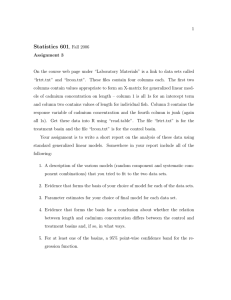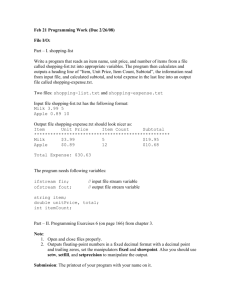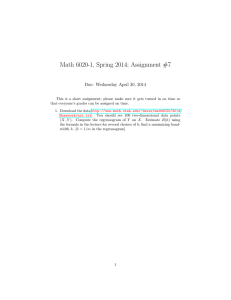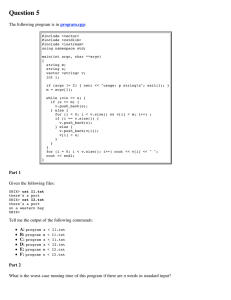Proficiency Test
advertisement
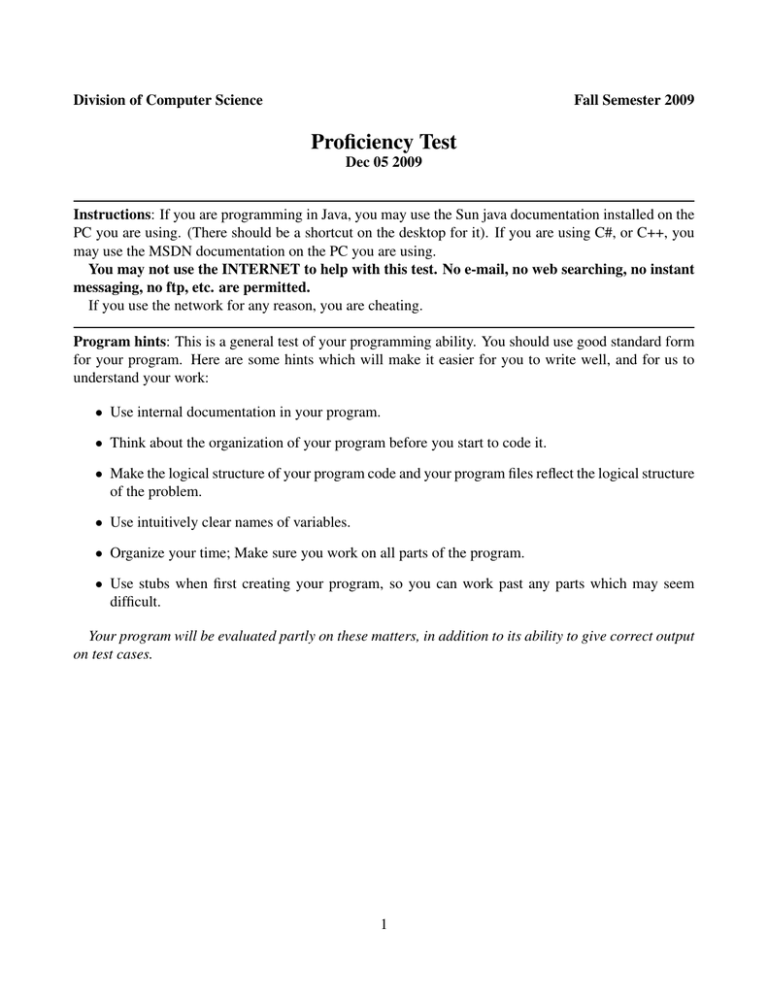
Division of Computer Science Fall Semester 2009 Proficiency Test Dec 05 2009 Instructions: If you are programming in Java, you may use the Sun java documentation installed on the PC you are using. (There should be a shortcut on the desktop for it). If you are using C#, or C++, you may use the MSDN documentation on the PC you are using. You may not use the INTERNET to help with this test. No e-mail, no web searching, no instant messaging, no ftp, etc. are permitted. If you use the network for any reason, you are cheating. Program hints: This is a general test of your programming ability. You should use good standard form for your program. Here are some hints which will make it easier for you to write well, and for us to understand your work: • Use internal documentation in your program. • Think about the organization of your program before you start to code it. • Make the logical structure of your program code and your program files reflect the logical structure of the problem. • Use intuitively clear names of variables. • Organize your time; Make sure you work on all parts of the program. • Use stubs when first creating your program, so you can work past any parts which may seem difficult. Your program will be evaluated partly on these matters, in addition to its ability to give correct output on test cases. 1 Problem statement: You are working in the Technical Support Department for Wildcat Enterprises. Wildcat Enterprises is a general merchandise company which sells four different products. The company uses salesmen, and needs to keep track of the sales by product and by salesman. The Manager of the Technical Support Department has asked you to develop some software to assist. You have been provided additional information, as given below. At the end of each day, each salesperson submits a slip for each type of product sold: 1. The salesperson ID 2. The product ID 3. The number of that product sold that day. Assume that the information from all slips for a month is stored in a file named slips.txt. There is another file, named price.txt, listing the price of each product. On the last day of a month, the company would like to generate two tabular reports, named salespersonPerformance.txt and salability.txt, to summarize the performance of each salesperson and the salability of each product, respectively. The overall performance of a salesperson is determined by the total value of products that he/she sold in this month, and the salability of a product is determined by the total value of the product sold by all salespersons in this month. More specifically, the tabular report salespersonPerformance.txt contains 6 columns. The first column is the salesperson ID. The next four columns are the numbers of sold items for each product. The last column is the total value. The rows of the report should be sorted in terms of the overall performance of salespersons in the decreasing order. The tabular report salability.txt contains 3 columns. The first column is the product ID. The second column is the total number of a product sold by all salespersons in a month. The last column is the salability. The rows of the report should be sorted in terms of the total values of products in the decreasing order. Implement an application that reads slips.txt and price.txt and outputs salespersonPerformance.txt and salability.txt. Input file examples: slips.txt personID 101 101 101 102 104 105 106 101 102 productID 2 3 1 1 2 3 4 1 2 2 number 1 4 2 10 15 20 10 3 2 price.txt productID 1 2 3 4 price ($) 10.0 15.0 20.0 12.0 Output file examples: salespersonPerformance.txt personID 105 104 101 102 106 product1 0 0 5 10 0 product2 0 15 1 2 0 product3 20 0 4 0 0 product4 0 0 0 0 10 salability.txt productId 3 2 1 4 total number 24 18 15 10 3 total value 480 270 150 120 performance 400 225 145 130 120
